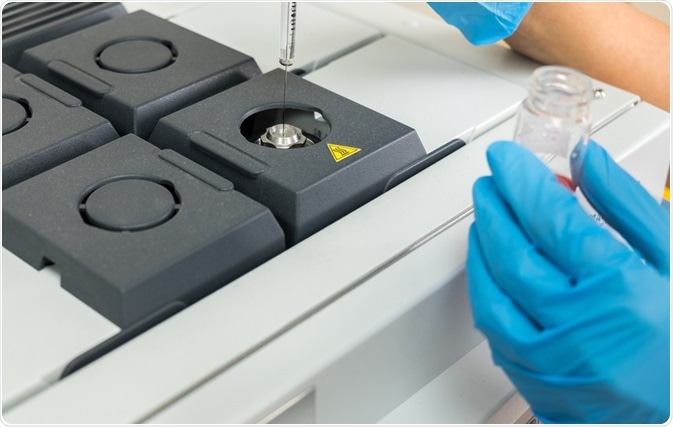Mass spectrometry is a highly sensitive and versatile tool that is commonly used by forensic scientists for the screening and identification of known and unknown substances.
 Lerner Vadim | Shutterstock
Lerner Vadim | Shutterstock
Types of mass spectrometry used in forensic science
In mass spectrometry, a sample is analyzed to determine its molecular composition through the generation of a spectrum that reveals the masses of its component parts.
A transfer line introduces the sample into the mass spectrometer, either directly or after passing it through a chromatography-based instrument to separate it into its constituent components. An ionization chamber at the inlet turns the components into charged ions, by removing at least one electron from the analyte.
This form of ionization is called electron ionization (EI), which is one of the most common methods used. However, alternative techniques include atmospheric pressure chemical ionization, chemical ionization, and matrix-assisted laser desorption ionization.
The ions can then be accelerated in a mass analyzer and separated from one another using a magnetic field, which deflects the ions to different degrees based on their masses. However, as with the ionization stage, alternative forms of mass analyzer are available.
In the case of EI, once the sample components are separated, ion beams then enter a detector, which generates an electric signal proportional to the number of ions hitting it. This creates a mass spectrum that shows the mass-to-charge (m/z) ratio of the individual component ions that were in the sample. This spectrum enables a forensic analyst to determine exactly which compounds the sample is composed of, using a combination of mass spectral libraries and their own expertise.
For greater resolution, forensic analysts may use quadrupole time-of-flight (Q-TOF) mass spectrometry, which separates sample components based on how long it takes for them to cross a certain distance within a vacuum, rather than separating fragments based on their mass-to-charge ratios.
Q-TOF MS provides extremely high specificity, which is useful to forensic scientists given the ever-expanding number of compounds that are being added to spectra databases as a result of so many new “designer” drugs being developed.
Nowadays, scientists are often handling drug compounds and drug metabolites that they have never previously encountered, making it necessary to screen for both known and unknown compounds.
Which sample types can mass spectrometry be used to analyze?
Mass spectrometry is widely applied in forensic science, with technological advances in the field further increasing the diversity and reliability of its applications.
Liquid Chromatography-Mass Spectrometry
Liquid chromatography-mass spectrometry (LC/MS) is a forensics technique frequently used by toxicologists to analyse substances for suspected illicit drugs and to confirm the findings of presumptive drug tests. Analysts might test the substances themselves, or human tissue or fluid samples to gauge whether an individual has ingested the substance, whether intentionally or not.
Some LC/MS-based screening techniques enable hundreds of drugs and their metabolites to be detected within minutes. Using the method, analysts can test dried blood to identify most drugs-of-abuse and their metabolites.
Some synthetic amphetamines and cannabinoids are continually modified to ensure they go undetected during standard testing, but some labs use a technique called ultrafast triple-quadrupole-LC/MS , which provides data-dependent analysis to quantitatively analyse known substances, whilst screening for unknown compounds at the same time.
Gas Chromatography-Mass Spectrometry
Many forensic labs use gas chromatography (GC) to separate samples for MS analysis. This has been the gold standard for many years because so many substances fragment to give a clear fingerprint once in the gas phase. For greater resolution still, a second MS analysis can be run (GC/MS/MS).
In suspected cases of arson, investigations often involve GC/MS due to the volatile nature of inflammable liquid samples. Analysis of fire accelerants taken from a suspected crime scene can confirm whether a substance was introduced intentionally or not.
Isotope Ratio Mass Spectrometry
Here, a technique such as GC is used to to separate samples before they enter an isotope ratio mass spectrometer where specific elements and isotopes within a sample can be analysed to determine how old a sample is using isotopic dating.
The technique involves measuring the different isotopic abundances of hydrogen, carbon, oxygen and nitrogen. Such variations can arise when biological, physical or chemical processes cause isotopic fractionation. The lightest isotopes are the most affected by fractionation, and the differences in isotope ratio values that occur as a result of fractionation effects are often specific to particular origins and production processes.
In forensics, scientists can use these tiny differences to link or distinguish between samples, even with only trace amounts of samples.
The future of mass spectrometry in forensic science
With the growing number of mass spectrometry applications in the field of forensics and the ever-increasing number of compounds that are being discovered, scientists will be able to identify smaller and smaller quantities of sample in the future, more quickly and accurately than has ever been possible before.
Techniques are more portable, paving the way for new opportunities to perform in-situ analysis outside of the forensics labs, in locations where the applications could be particularly beneficial such as within airports or at the scenes of crimes.
Sources
- https://aboutforensics.co.uk/mass-spectrometry/
- http://aboutforensics.co.uk/isotope-ratio-mass-spectrometry/
- forensicrti.org/fundamentals-of-mass-spectrometry-used-in-toxicology/
- massspectrometrycongress.alliedacademies.com/…/mass-spectrometry-inforensic-science
- ec.europa.eu/…/inorganic-mass-spectrometry-tool-destructive-nuclear-forensic-analysis
Further Reading
- All Forensics Content
- Epigenetics and Forensics
- Chromatography in Forensic Science
- Overcoming DNA Degradation in Forensic Science
- Reducing PCR Inhibition in Forensic Science
Last Updated: May 24, 2019

Written by
Sally Robertson
Sally has a Bachelor's Degree in Biomedical Sciences (B.Sc.). She is a specialist in reviewing and summarising the latest findings across all areas of medicine covered in major, high-impact, world-leading international medical journals, international press conferences and bulletins from governmental agencies and regulatory bodies. At News-Medical, Sally generates daily news features, life science articles and interview coverage.
Source: Read Full Article
